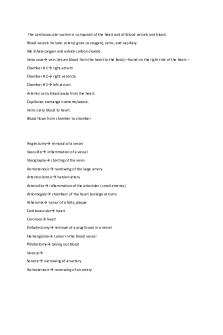Secondary Assessments - Cardiovascular PDF

| Title | Secondary Assessments - Cardiovascular |
|---|---|
| Course | Emt-1/Basic |
| Institution | Orange Coast College |
| Pages | 1 |
| File Size | 46.5 KB |
| File Type | |
| Total Downloads | 65 |
| Total Views | 129 |
Summary
Secondary Assessments...
Description
CARDIOVASCULAR SECONDARY ASSESSMENT
OPQRST ?s
Circumstances will dictate which aspects of the physical examination will be used Begin with Cardiovascular System Evaluate
Patient's circulation by assessing pulses at various locations
Assess
Skin color, temperature & condition Is the skin cool or moist? How do the mucous membranes look? Are they pink, ashen or cyanotic?
Onset Provocation
Is it positional? Does a deep breath or palpation of the chest make it worse? Did you take anything for it? Including anything non-prescribed Quality
Ask patient to describe their pain. Let patient use their own words.
Does the patient have any edema in the extremities, especially the lower extremities? *All of these physical findings can help identify poor circulation,
If patient is unable to describe pain, provide list "There are lots of different kinds of pain. Is your pain more like heaviness, pressure,
which may have been caused by failure of cardiovascular system
burning tearing, dull ache, stabbing or needle like? Region/ Radiation
Examine Respiratory System Evaluate
Looking for signs of inadequate ventilation
Assess
Are the lung sounds clear? Are breath sounds equal? Are neck veins distended? Is the trachea deviated or is it midline?
Vital Signs Measure & record vital signs Pulse, respirations & blood pressure, if available pulse oximetry
TREATMENT
When did the problem begin, and what does the patient think may have caused it? Ask what makes the pain or discomfort better or worse.
Severity
Ask where the pain is located and whether the pain has spread to another part of the body Ask the patient to rate pain on a simple scale of 1-10 10 is the worst pain imaginable Used to check if patient's pain is getting better or worse during reassessments
Timing
Find out how long the pain lasts when it is present or whether it has been intermittent or continuous...
Similar Free PDFs

Formative Assessments
- 3 Pages

Development Secondary
- 4 Pages

Assessments ggz
- 2 Pages

Aerobic and MSK Assessments
- 7 Pages

Chapter 22 assessments
- 2 Pages

WAU2 Peer Assessments - asdfsad
- 4 Pages

# Assignment pack - assessments
- 33 Pages

Primary AND Secondary Survey
- 3 Pages

AV Assessments Summary
- 3 Pages

Cardiovascular system
- 2 Pages

Cardiovascular disorders
- 30 Pages

Cardiovascular System
- 2 Pages

Manual(Cardiovascular)
- 12 Pages
Popular Institutions
- Tinajero National High School - Annex
- Politeknik Caltex Riau
- Yokohama City University
- SGT University
- University of Al-Qadisiyah
- Divine Word College of Vigan
- Techniek College Rotterdam
- Universidade de Santiago
- Universiti Teknologi MARA Cawangan Johor Kampus Pasir Gudang
- Poltekkes Kemenkes Yogyakarta
- Baguio City National High School
- Colegio san marcos
- preparatoria uno
- Centro de Bachillerato Tecnológico Industrial y de Servicios No. 107
- Dalian Maritime University
- Quang Trung Secondary School
- Colegio Tecnológico en Informática
- Corporación Regional de Educación Superior
- Grupo CEDVA
- Dar Al Uloom University
- Centro de Estudios Preuniversitarios de la Universidad Nacional de Ingeniería
- 上智大学
- Aakash International School, Nuna Majara
- San Felipe Neri Catholic School
- Kang Chiao International School - New Taipei City
- Misamis Occidental National High School
- Institución Educativa Escuela Normal Juan Ladrilleros
- Kolehiyo ng Pantukan
- Batanes State College
- Instituto Continental
- Sekolah Menengah Kejuruan Kesehatan Kaltara (Tarakan)
- Colegio de La Inmaculada Concepcion - Cebu


